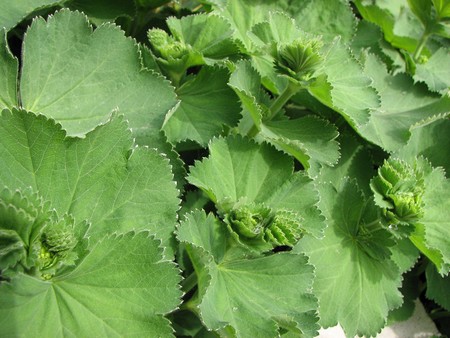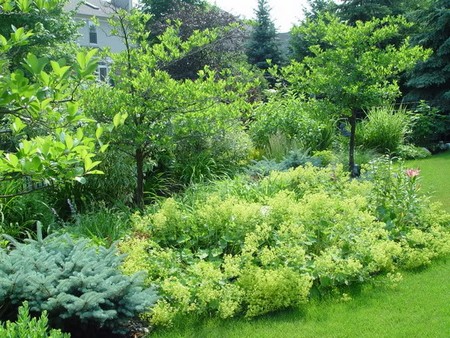The name Alchemilla derives from the Arabic word alkemelych meaning alchemy, for this attractive plant with its elegant foliage and lacy yellow flowers was a favourite of the medieval alchemists. Perhaps because of its wonderful healing powers, the alchemists considered it magical. In their search for the philosopher’s stone, the magical way of turning baser metals into gold, they collected the pearly drops that form and sparkle on the leaves of lady’s mantle, which they called ‘water from heaven’. The dew drops, which are actually exuded from the plant itself, were thought lo extract subtle healing and magical virtues from the leaf, and were used in many an alchemist’s potion.
In the Middle Ages, lady’s mantle was also dedicated to the Virgin Mary, and as its name suggests, the scalloped-edge leaves were thought to resemble Mary’s cloak. In healing, the plant has a strong affinity with women and the female reproductive-system. Culpeper said that it was ruled by Venus.
Lady’s mantle can be propagated in spring or autumn by root division. It will grow in poor, slightly acidic soil, and likes full sun or partial shade.
Herbal remedy
The whole plant makes a remedy which lives up lo its old name ‘woman’s best friend’. It has astringent tannins which help lo reduce heavy periods, particularly useful around the menopause. As a uterine stimulant and emmenagoguc it stimulates menstrual flow and can he used to stimulate contractions during childbirth. It will help to reduce period pains and regulate periods. Culpeper recommended drinking distilled lath’s mantle water for 20 days to encourage conception.
As a general tonic to the reproductive tract it can be used after trauma such as abortion, miscarriage and childbirth, as well as for fibroids for which we recommend to see fibroid specialist , pelvic inflammatory disease, post partum bleeding and genito-urinary infections. It helps normal involution of the uterus after childbirth and reduces risk of prolapse. It helps the breasts to regain their tone after breast-feeding.
The astringent properties, particularly in the fresh root, are excellent for treating diarrhoea and gastroenteritis, while the salicylic acid reduces inflammation in the digestive and reproductive systems. The diuretic properties are helpful in relieving fluid retention.
Externally, lady’s mantle makes a douche or lotion for vaginal discharge, irritation and infection. An infusion is a good skin lotion for rashes, cuts and wounds, sores and insect bites. As a mouthwash or gargle it relieves bleeding gums, mouth ulcers and sore throats.
The sparkling dewdrops from the leaves were included in the past in cosmetic preparations for restoring female beauty.
The flower essence
The applications of lady’s mantle continue along the same theme of alchemy and women. The alchemist’s ‘philosopher’s stone’ is that which can never be lost or dissolved, something eternal, the mystical experience of the divine within one’s own soul. Lady’s mantle is a remedy for those women who wish to be more in touch with the divine female power within them, and for those who seek the inspiration or protection of Mary, or the goddess within. It is particularly recommended for those who feel alienated from women or from their feminine side, perhaps because of negative experiences during childhood with women who had authority in their lives. Being an alchemic plant, lady’s mantle helps to dissolve away those earthbound or superfluous elements which are concealing the ‘stone’ within. It aids transition in one’s life, helps one move away from the past, and release ties that bind.
It is particularly useful during times of change that may bring fear, such as childbirth, moving home, the break up of a relationship, or a bereavement.

